A Dozen Reasons to Drink Beaujolais: Complex And Easy-Going Reds by Six Producers in Twelve Appellations including Ten Crus (Memorial Day Dozen $399)
Join us for Saturday Sips
Come as you are; come any time that’s convenient for you during our business hours to sample selection from this week’s selections. Our staff will be on hand to discuss nuances of the wines, the terroirs reflected, and the producers.
“First there is a mountain, then there is no mountain, then there is.”
Donovan’s cryptic 1967 nod to Buddhist philosophy might be applied equally to the evolution of Beaujolais in the minds of many wine drinkers: The immensely ‘likeable’ wine offers a perfect introduction to the hedonistic pleasures of French wine, but once tastes expand, it may seem somewhat simplistic and one-dimensional. Lacking the snob appeal of pricey Burgundy or window-dressing Bordeaux, Beaujolais can be shoved to a back burner and remembered primarily for the fun, early-release Kool-Aid known as Beaujolais Nouveau. But once palates expand to appreciate nuance of grape variety and the technicality of cellar styles, the world becomes larger and a return to the beauty of Beaujolais is a transcendental joy.
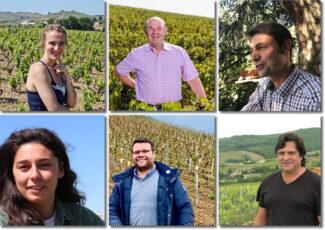
Top row: Marie-Élodie Zighera (Clos de Mez), Pierre-Marie Chermette (Domaines Chermette), Claude-Édouard Geoffray (Château Thivin)
Bottom row: Laura Lardy, Valentin Montanet (La Soeur Cadette), Guy Breton
This week’s package includes a sampling from various quality strata in Beaujolais. Each will leave its own unique imprint on the senses; each is made by vignerons who are representative of the current mood in the appellation as well as the historical significance. These are ideal wines with which to celebrate Memorial Day—lodestars for light, bright red wines that are best served with a significant chill.
The Original Thirst Quenching Wine
Nobody loves pretense more than the French, and nobody is better than the French at putting pretense aside for a moment to savor life’s pleasures. ‘Vins de soif’ are wines that Americans call ‘quaffers’ and are meant to satisfy the most primal of gustatory needs: Thirst quenching. This is not to say that the enjoyment level of vins de soif is restricted to the basics; often they contain elements that are universally appealing—sensations of sweetness and a profusion of fruit and spice.
No place on earth is more representative of these qualities than Beaujolais, the original vin de quaff. Overlapping both Burgundy and the Rhône, paying homage to both while owing allegiance to neither, the picturesque vineyards of Beaujolais are planted almost exclusively to Gamay and have been producing accessible, fruit-forward wines since the Romans first established trading routes along the Saône valley.
Arguably, these are not special occasion wines, but rather, every day wines. And along with their universal appeal comes a universal truth: We are granted far more ‘every days’ than we are highlight moments.

Clos de Mez
Marie-Élodie Zighera has roots in the past; a metaphor that is not really a metaphor since her oldest vines were planted so long ago that when France entered the First World War, they were already producing.
“Vines have been in my maternal family for four generations,” she says. “The grapes they grew were delivered to the cooperative cellar by my grandmother and mother up until I arrived at the domain as a winegrower. However, this did not deter my grandmother or mother from taking great care of our 17-hectare vineyard. At that time, I was living in Paris with my family and we would come to Fleurie for the holidays. I used to love this time so much, being in close contact with nature.”
With a drive to turn this love into a vocation, Zighera studied viticulture; after graduation, she found work in a number of vineyards. Among them was Clos Vougeot, where she concluded that she could not hope to make such wines from her family holding.
Then came the eureka moment: “A professional tasting of old vintages was held and I was invited to attend during my work placement at Vougeot. With a Morgon 1911, the unanimous opinion was that it was magnificent wine; that it had aged as well as a Burgundy. I finally knew what type of wine I wanted to make and most importantly I realized it was possible. I had another strong advantage too: the freedom to imagine without guidelines being imposed. I set up my business in 2006 and named the domain Clos de Mez, a shortened version of my name.”
Zighera makes wine in Fleurie and Morgon, where the average age of vines in her plots is 45 years. Her Fleurie holding outlines a hilly landscape, where Gamay vines follow the contours of the slopes of Fût d’Avenas, the mountain passes of Durbize, Labourons and Raymont Peak. She says, “Legend recounts that a Roman legionary once passed through here, leaving his name to the site and to the village. Our vines in Fleurie are found in the southern part of the appellation, bordering Morgon. Facing South/South-East, they stand at an altitude of about 300 meters. The soils of Fleurie La Dot and Fleurie Mademoiselle M, which originate from acid rock, are deep and provide good drainage. Rose colored granite is widely predominant here and is found in the form sand called saprolite.”
Cru Morgon
Morgon, on the western side of the Saône, may only appear on the label of a Gamay-based red wine; even so, the appellation allows the addition of up to 15% white wine grapes: Chardonnay, Aligoté or Melon de Bourgogne. Nevertheless, the wines of Morgon wind up being among the most full-bodied in Beaujolais, with the potential to improve in the cellar so consistently that the French describe wines from other AOPs that display this quality by saying, “It Morgons …”
The vineyards occupy slightly under five square miles surrounding the commune of Villié-Morgon, with the vines of Fleurie and Chiroubles directly to the north and Brouilly and Regnié along the southern border.
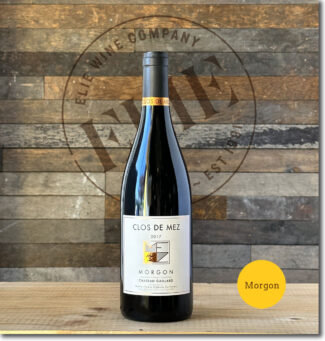 Clos de Mez, 2017 Morgon-Château Gaillard ($32)
Clos de Mez, 2017 Morgon-Château Gaillard ($32)
Chateau Gaillard is a lieu-dit that passed to Marie-Élodie from her grandmother. Adjacent to the border of Morgon where it borders Fleurie, the plot of 60+ year old vines with very low yields giving a wine of great depth and ageing potential. Grapes are sorted as they are picked in each plot of the vineyard; the grapes are moved to the vats by a system of gravity where whole-bunch pre-fermentation maceration at cold temperature is carried out for few days, followed by alcoholic fermentation interspersed by cap-punching and pumping-over. The wine offers ripe, black-fruit character with lively acidity and an expansive finish.
Cru Fleurie
Each of the Beaujolais crus wears its own face; where Morgon is bold and handsome and Saint-Amour is a fairyland of delicate beauty. Fleurie—covering an unbroken area of three square miles—represents Beaujolais’ elegance. The terroir is built around pinkish granite that is unique to this part of Beaujolais, with the higher elevations accounting for thinner, acidic soils that produce graceful and aromatic wines. Below the main village, the wines are grown in deeper, richer, clay-heavy soils and the wines themselves are richer and deeper and appropriate for the cellar. The technique known as gridding, which involves extracting more color and tannin from the skins of the grapes, is proprietary to Fleurie.
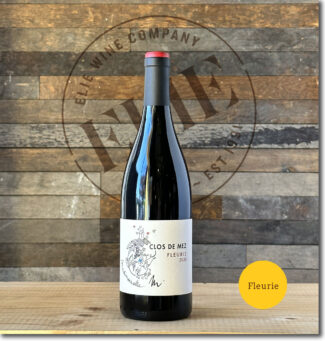 Clos de Mez ‘Mademoiselle M’, 2020 Fleurie ($28)
Clos de Mez ‘Mademoiselle M’, 2020 Fleurie ($28)
La Dot refers to the dowry that Marie-Élodie’s grandmother received, and this wine pays homage to her. From a plot of 50-year-old vines located in the southern sector of Fleurie, close to the border of Morgon, it is produced from gnarled old goblet pruned vines grown on decomposed sandy pink granite and made from very low yields. 40 to 50% of this wine is matured in barrels for 9 months, leading to a dense, somewhat balsamic style of Fleurie with dark fruit notes and spicy complexity.
Pierre-Marie Chermette – Vissoux
When a winemaker tries to bottle something for everyone, he/she is not always successful. The father, daughter and son team of Martine, Pierre-Marie and Jean-Etienne Chermette of Domaine du Vissoux are the exception to prove the rule, producing high quality white, red and Beaujolais rosé from crus such as Brouilly, Fleurie, Moulin-à-Vent, Saint-Amour, Crémants de Bourgogne as well as hand crafted fruit liqueurs, cassis and vine peach with ginger.
The family is considered a beacon of Beaujolais excellence, able to broadcast the region’s varied terroirs with authority: Old vines, diligent but traditional vinification and élevage in foudre are the rudiments of their approach.
Cru Moulin-à-Vent
At the top of Beaujolais, geographically and (arguably) in terms of quality, Moulin-à-Vent’s oddly toxic soils produce wines of great merit. Manganese exists here in quantities not found anywhere else in Beaujolais; it retards leaf growth and creates smaller bunches, resulting in wines of phenomenal concentration that can be cellared for a decade or more.
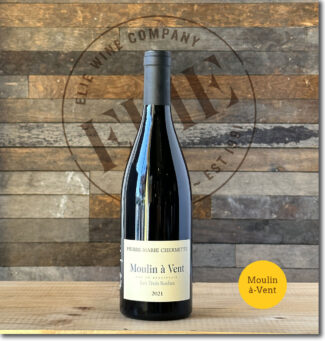 Pierre-Marie Chermette Vissoux ‘Les Trois Roches’, 2021 Moulin-à-Vent ($33)
Pierre-Marie Chermette Vissoux ‘Les Trois Roches’, 2021 Moulin-à-Vent ($33)
The three ‘Roches’ referred to are the trio of lieux-dits from which the grapes are drawn; the Rochegrès plot, La Rochelle, which overlooks the old moulin-à-vent windmill, and Roche Noire. According to Pierre-Marie, “The east-facing Rochegrès gives the wine finesse and supple tannins; south-east facing La Rochelle gives the cuvée its framework with power and depth while the Roche Noire grapes contribute liveliness and fruit.”
The manganese-rich subsoil results in a wine that is supple, redolent of wild berries, spices, rose petals and orange rind showing, sparkling tangy acids and melting tannins.
Cru Brouilly
Nestled along slopes of a dormant volcano, Brouilly is the most southerly of the Beaujolais Crus. The proximity of the volcano has left the area saturated with rare blue diorite, a phenomenon that leaves the soil thin and stony—an ideal underbelly for deeply rooted, low yielding vines with an excellent concentration of flavor. The best vineyards of Brouilly are planted on the south-east-facing slopes of the mountain, where the vineyards are protected from winds from the nearby Beaujolais hills by Mont Brouilly itself, and are instead subject to early morning sunlight.
Brouilly covers land in six communes surrounding Mont Brouilly, none of which (unusual for a Beaujolais cru) are named Brouilly. The area gets its name from the hill, which in turn takes its name from a Roman lieutenant, Brulius, who is thought to have planted vines here some 2000 years ago.
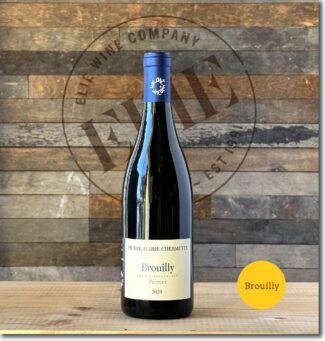 Pierre-Marie Chermette Vissoux, 2020 Brouilly–Pierreux ($31)
Pierre-Marie Chermette Vissoux, 2020 Brouilly–Pierreux ($31)
A textbook-perfect Brouilly from south-facing vines planted on granite scree. The lieu-dit name ‘Pierreux’ comes from the French word for stones, illustrating the make-up of the soil. The wine undergoes traditional Beaujolais processing, half-carbonic maceration with two pump-overs per day; 10 to 12 days of maceration in concrete tanks follow with no chaptalization, natural yeasting and bottling using a minimum of Sulfur. The wine is crisp, fruit-forward and juicy with expressive aromas of ripe raspberries and wild strawberry, savory spice and zesty acidity.
Cru Saint-Amour
The remarkable terroir of Saint-Amour sounds less romantic than the name, being predominantly Piedmont deposits, granite, limestone and clay. But this poetry-inspiring appellation, the most northerly of the ten Beaujolais cru areas, is located just to the south of the Mâconnais appellations of Pouilly-Fuissé and Saint-Veran.
As suits the name, the wines of Saint-Amour are light and delicate, the result of dry, warm winds from the north that keeps soils feathery-textured. Although Gamay is the predominant variety grown, it’s no wonder that this appellation produces more white wines than the other Beaujolais cru, although these Chardonnay/Aligoté –based wines often wear generic labels or are listed under the Saint-Veran (Burgundy) appellation that slightly overlaps Saint-Amour.
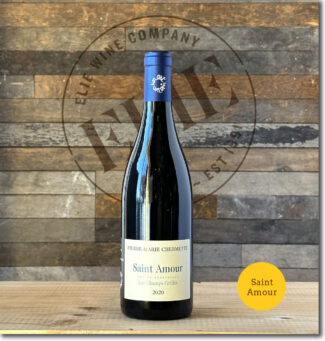 Pierre-Marie Chermette – Vissoux, 2020 Saint-Amour Les Champs Grillé ($32)
Pierre-Marie Chermette – Vissoux, 2020 Saint-Amour Les Champs Grillé ($32)
Les Champs-Grillés is a south-facing lieu-dit where the soil is made of noble granites that tend to give the wines full bodies that may be mistaken for a Moulin à Vent. The wine shows this weight, beginning with aromas of raspberries, rose petals, warm spices and orange rind and moving to a crunch mid-palate with crunchy red fruit and nicely integrated tannins.
Beaujolais
Brooding Beaujolais is an oxymoron; buoyant Beaujolais is a requirement. The broadest of all the classifications in Beaujolais, seeing such a designation on a wine label means that the grapes are generally grown in the southern part of the appellation and vinified using carbonic or semi-carbonic maceration, leaving dominant, candy-like notes.
Beaujolais’ climate is similar to Burgundy—moderate continental—and the main difference in the output is that whereas Burgundy’s Pinot Noir is fickle and difficult to ripen, Beaujolais’ rock star Gamay is an early-budding, early-ripening and vigorous cultivar. As such, outputs (if not controlled) can be overly prodigious.
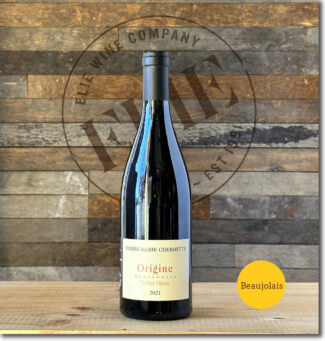 Pierre-Marie Chermette Vissoux ‘Origine Vieilles Vignes’, 2021 Beaujolais ($20)
Pierre-Marie Chermette Vissoux ‘Origine Vieilles Vignes’, 2021 Beaujolais ($20)
First released in 1988 as a cuvée of non-chaptalized Beaujolais Nouveau made using grapes from old vines, the wine comes from 20 acres of Gamay in Saint Vérand. The plot enjoys south-western exposure on dark granitic soil and the vines, between 35 and 100 years old, rely on Guyot and Cordon de Royat pruning. The wine is so inky you might mistake it for Syrah; but the fruit remains red punchy, and as Jancis Robinson says, “It is wine for drinking rather than contemplating.”
Château Thivin
Château Thivin is the oldest wine-growing estate in Mont-Brouilly, and they pride themselves as offering a château on a ‘human scale’ where six generations of the Geoffray family have been cultivating grapes since 1877 when Zaccharie Geoffray purchased the estate. His son Claude expanded the property over the next few decades, and his son (also named Claude) boosted the prestige of the zone in the face of the Great Depression when he played a pivotal role in the creation of the Côte de Brouilly appellation.
Thivin’s parcels are predominantly south-facing and are planted entirely with Gamay vines that now average 50 years of age. As a nod to biodynamics, the soil is plowed and composted regularly while cover crops are left between some rows to encourage microbiotic activity; no insecticides are used. According to Claude-Édouard Geoffray, “On a slope where grades reach 48% and the surface is crumbly, implementing these techniques is essential to safeguard the soil from erosion, but it isn’t easy! Each section of the vineyard is harvested and vinified separately to preserve the unique characteristics afforded by variations in exposure and altitude.”
In 2014, Claude-Édouard’s wife Sonja introduced a small herd of dwarf sheep to the Château’s walled vineyard. She says, “These little sheep, of the Ushant breed, graze in among the vines after the grape harvest until the buds burst, helping to maintain the green cover between the rows of vines,” adding, “During the growing period, the sheep are moved to the tree-lined meadow alongside the plot.”
Cru Côte de Brouilly
To suggest that Côte de Brouilly erupts with flavor is more than a metaphor; the appellation sits on the slope of an extinct volcano. Making up but a small fraction of the Brouilly appellation, Côte de Brouilly draws its unique terroir from volcanic blue diorite, which provides the thin, well-drained soil that causes vines to struggle and the resulting wine—concentrated and intense—to shine. The vineyards of Côte de Brouilly are found on the south and east slopes of Mont Brouilly, protected from winds from the nearby Beaujolais hills by the volcano itself. They enjoy morning sunlight maximized by the steep slopes of the vineyards. This hastens ripening so that the vineyards of Côte de Brouilly are among the first to be harvested in Beaujolais.
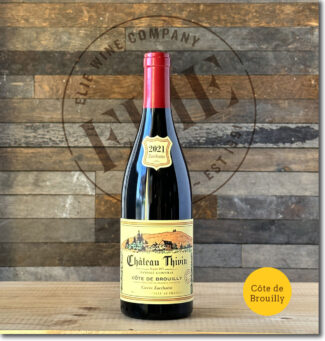 Château Thivin ‘Cuvée Zaccharie’, 2021 Côte de Brouilly ($64)
Château Thivin ‘Cuvée Zaccharie’, 2021 Côte de Brouilly ($64)
Thivin’s flagship wine is an homage to Zaccharie Geoffray and comes from a selection of the estate’s best terroirs on the south-eastern slopes of Colline de Brouilly, where the terroir is built from fine, well-drained soil igneous origin (diorite porphyry) mixed with clay. The east and south-facing vines planted at high density and pruned into low goblets—Thivin relies on ‘green picking’ to obtain a lower, concentrated yield. The wine matures for 11 months in barrels. In spite of the substantial tannins that anchor this wine, it shows liveliness and alacrity, blending pepper, small macerated black fruit and mineral tones seamlessly.
Laura Lardy
“I tried to escape the winemaking fate, but to no avail,” says Laura Lardy. “After a couple of years trying my hand at something else, I went back to the family estate in 2015. And in 2017, when I was 27, the first vintage of my own wine was born.”
To an outsider, Laura Lardy’s career seems a bit inevitable; she is the fourth generation of a Fleurie winemaking family. Her father Lucien and brother Yohan are both active vignerons, making wines under their respective names, and Laura herself recalls how she was always keen on following her father in the vineyards from a tender age. Her path diverges in her devotion to organics–she started to convert the 13 acres of vines she rents from her father as soon as she took them over, led by the conviction that preserving the indigenous yeasts on the grape skins and respecting the soils leads to fewer chemical interventions in the cellar as well as a more faithful terroir reflection in the wine.
“I knew that if I was to make wine, it would have to be this way, no matter how hard it is in the beginning,” Laura asserts. “I try to be as respectful of the environment in my daily life, so it’s obvious I want to be just as careful about the ecology and waste management in my work.”
Cru Chénas
Wine from Chénas may be considered the rarest among the Crus, both in terms of quantity and the rarified flavors owed, in part, to the quartz found in certain parcels. Straddling the communes of Chénas and La Chapelle-de-Guinchay, it offers the smallest surface area of the Crus, although there are a dozen named lieux-dits that each display a unique personality.
Named for the ancient oak forests that once blanketed the commune (cleared first by the Gallo-Romans and then by local monks), the vines that replaced them are planted exclusively to Gamay, which offers Chénas wines characteristic notes of small black fruit, peony and spices highlighted by soft tannins.
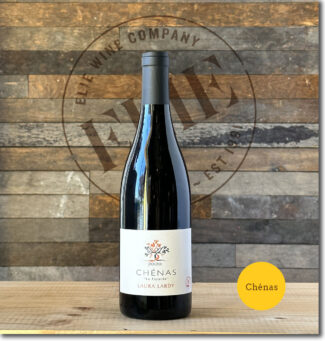 Laura Lardy ‘La Fayarde’, 2020 Chénas ($37)
Laura Lardy ‘La Fayarde’, 2020 Chénas ($37)
The wine originates from 40-year-old vines planted on sand and granite with a north-east exposure. True to Laura’s philosophy, grapes are hand-harvested and sorted, then spontaneously fermented in whole bunches in concrete tanks using traditional carbonic maceration. Following this is a slow press directly into old barrels where the wine rests for 6 months, then is bottled without fining or filtration, using minimum sulfur. The wine shows ripe black currant and blackberry, offering rich tannins and pronounced acidity, making this a wine that will respond well to aging.
Beaujolais-Villages
Of the three Beaujolais classifications, Beaujolais-Villages occupies the middle spot in terms of quality. To qualify, the wine generally hails from more esteemed terroirs in the northern half of Beaujolais, and from one of 38 villages that have not been named ‘Cru’ appellations. They are expressive wines with more structure and complexity than generic Beaujolais, though not as exclusive as those from the ten Crus.
Accounting for about a quarter of all Beaujolais production, Villages-level wines are most often produced by négociants and vinified using stricter rules as to yields and technique.
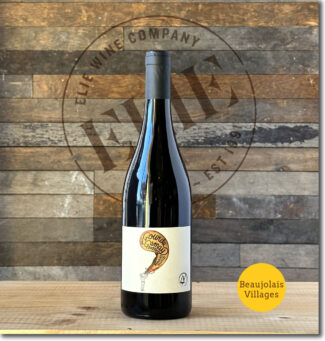 Laura Lardy ‘Gourde à Gamay’, 2020 Beaujolais-Villages ($25)
Laura Lardy ‘Gourde à Gamay’, 2020 Beaujolais-Villages ($25)
Grapes for this cuvée come from granitic soils in the Lantignié commune. In typical Beaujolais style, the hand-harvested fruit is carbonic macerated as whole bunches in concrete tanks with indigenous yeast, then pressed and matured for 10 months in concrete. It is bottled unfined, with a small dose of Sulfur. The wine is bone-dry, of course, but gives an impression of sweetness through the ripe red fruit; there is a touch of earth, as is characteristic of Villages-level Beaujolais, light and refreshing.
La Soeur Cadette
Valentin Montanet is a grower/maker in the small village of Saint-Père along a little creek to the southeast of Vézelay, a geographic appendage of Chablis. In 1997, the Institut National des Appellations d’Origines awarded Vézelay its own AOP, and in 2010, Valentin joined his parents at Domaine de la Cadette and now manages it, espousing his parents’ philosophy of organic farming and natural vinification to craft refreshing, mineral-driven whites and reds.
The family’s Vézelay vineyards are deep in the Morvan, the great mountain range that runs west by northwest of the Côte d’Or. The land here is quite exceptional: The creation of the granite massif of the Morvan has uplifted a marl and limestone strata, revealing fossilized marine deposits. Vézelay soils are not the same as those of Chablis; instead of the Kimmeridgean clay, the clays here range from blue and gray to red, sometimes replaced by shallow limestone. While the climate is slightly cooler than in Chablis, the vines enjoy great sun exposure, lending a balance between generous fruit and deep mineral structure.
Cru Juliénas
Juliénas, at the northern end of the Crus, is also among the most elevated. Slopes are steep, but this verticality is ideal for sunshine basking, allowing grapes to ripen easily here, giving the wines more flesh and backbone. The terroir is as varied as any in a single Cru, with less granite and more ‘blue stone’—a friable, decomposed volcanic schist that the locals call ‘terre pourrie’, or ‘rotten rock.’ The many soils of Juliénas produce such an array of wines that there is no true Juliénas style, although they can be counted on to display a heart of stone and a soul of fresh forward fruit.
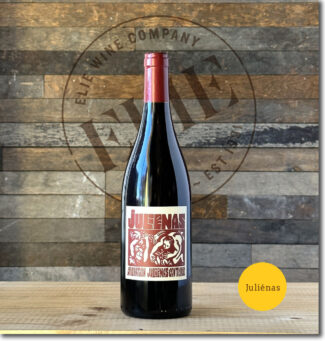 La Soeur Cadette, 2021 Juliénas ($34)
La Soeur Cadette, 2021 Juliénas ($34)
When weather ruined his 2016 Burgundy harvest, Valentin Montanet turned disaster into opportunity by acting on a long-held dream: To make Beaujolais, a tradition he has continued ever since. The thread of Burgundy remains evident in the bottles, which originate from six acres with vines 40 years old, but the wine is distinctly Juliénas—graceful, with crunch, fruit and minerality.
Guy Breton
Guy Breton took over the family domain from his grandfather in 1986—up until then, the family had been selling their fruit to the large cooperative wineries which dominated the region. The rise of imported yeast cultures to impart flavor and aroma, the use of high-tech carbonic maceration and the widespread commercialization of Beaujolais Nouveau played hell with the region’s reputation, and to much of the wine world, Beaujolais came to be seen as one-dimensional, lacking any expression of the native terroir.
Following the example of traditionalist Jules Chauvet, Guy and three other local vignerons initiated a ‘back-to-nature’ movement, calling for called for a return to the old practices of viticulture and vinification. This began with old vines and refusing to use synthetic herbicides or pesticides. They harvested late and sorted rigorously to remove all but the healthiest grapes, adding minimal doses of sulfur dioxide or none at all, and refusing both chaptalization and filtration.
“The end result allows my wine to express itself naturally,” he says, “without make-up or plastic surgery: rustic, spicy, loaded with schist minerals and at the same time, refreshing and deep-down delicious.”
Cru Chiroubles
Chiroubles is relatively tiny, with fewer than a thousand acres under vine, but it is a mouse that roars. This is due mostly to elevation: Chiroubles vineyards are the highest in Beaujolais, with some planted 1500 feet above the Saône River valley. Taking advantage of extreme diurnal shifts between the warm days and cold nights, the same soils that produce Fleurie to its immediate north here build wines that are lighter and fresher, often with pronounced floral characteristics.
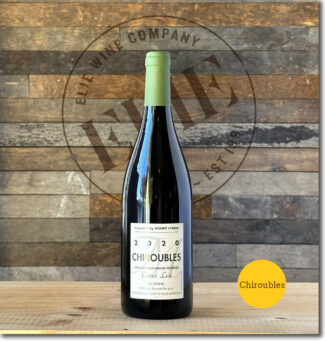 Guy Breton ‘Cuvée Léa’, 2020 Chiroubles ($39)
Guy Breton ‘Cuvée Léa’, 2020 Chiroubles ($39)
Guy Breton loves to vinify in a style that is light, bright and juicy—as such, the high-altitude, steep, decomposed granite slopes and old vines of Chiroubles are well suited. From three, recently acquired acres of 60-year-old vines, ‘Cuvée Léa’ shows floral, succulent aromatics bursting with notes of forest berries, and so delicate on its feet that it serves as a user-friendly counterpoint to some of the more structured Cru wines from Beaujolais.
Cru Régnié
Many Beaujolais wines are best consumed in their youth, and this is a quality emphasized with gusto by Régnié, the youngest of the Beaujolais crus. In fact, it wasn’t until 1988 that a group of 120 wine growers lobbied to get the appellation officially recognized, pointing out the newcomer in the family has plenty to offer: Its favorable geographical location between its two brothers, Brouilly and Morgon, allows the production of wines of a unique fruitiness.
Often called the ‘Prince of the Crus,’ Régnié’s terroir is distinguished by the pink granite soils found high in the Beaujolais hills. Here, at some of the highest altitudes in the region, vines are planted on coarse, sandy soils that are highly permeable and drain freely, an environment which is well suited to the Gamay grape variety.
Further down the slopes, higher proportions of clay with better water storage capabilities lead to a slightly more structured style of wine. The variation within the vineyard area allows growers to produce everything from fresh, light wines to heavier, more age-worthy examples of Régnié.
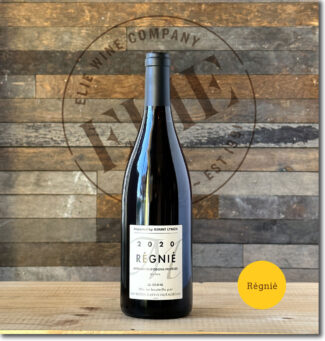 Guy Breton, 2020 Régnié ($36)
Guy Breton, 2020 Régnié ($36)
The vineyards of Régnié sit high on the slope between Brouilly and Morgon, and the wines often show the perfume and brightness of the former along with the mineral-driven structure typical of the latter. Add to that Breton’s house style, wines are designed to be drunk with abandon. As Breton himself puts it, “ At first, a dollop of supple, juicy fruit evokes the sandy layer of topsoil into which these Gamay vines—many of them a century old—sink their roots. Then a granite kick, full of gritty spice, clutches the palate with gusto, conjuring the stony bedrock beneath.”
The Nazi-Defying Kir Cocktail: Burgundy’s Version of ‘Victory Garden’
The classically refreshing Kir cocktail is made with one part crème de cassis and four parts dry white wine, ideally Aligoté. It was named after Felix Kir, a Catholic priest and decorated member of the French resistance. When Nazi soldiers marched into Dijon, Burgundy, in 1940, many local officials fled. Kir remained in the city, helping more than 4,000 prisoners of war escape from a nearby camp. It is said that when Nazis confiscated Burgundy’s iconic red wines, Kir defiantly devised his namesake cocktail by combining the available dry white wine, Aligoté, with blackcurrant liqueur in an attempt to mimic the color of Burgundy’s Pinot Noirs.
It is the sort of story you hope against hope is true. While Americans were planting victory gardens, the French were fighting in the underground and advancing the cause of liberté, égalité, fraternité … and Aligoté, which combined with crème de cassis becomes one of the most delightful summertime aperitifs of all time.
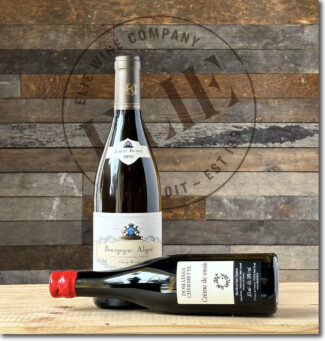
Domaines Chermette, Crème de Cassis – Beaujolais Blackcurrant Liqueur ($21) 375ml
Produced from homegrown Noir de Bourgogne blackcurrants harvested each July; this type of currant produces small, concentrated, strongly-flavored berries and is different from everyday ‘eating’ blackcurrants. The fruit is crushed, then steeped in neutral sugar beet alcohol for two months, then blended with beet sugar. The crème de cassis is brought to the correct alcohol by volume by adding neutral alcohol or water—the art lies in finding the correct balance between fruit juice, sugar and alcohol. Bottling takes place throughout the year because, the more recently the crème has been made, the better it is.
+
Domaine Adélie, 2020 ‘Champ Renard’ Bourgogne-Aligoté Blanc ($28)
Comprising 20 acres of various Mercurey lieux-dits (including the Premier Cru, Champ Martin), Domaine Adélie was named for the daughter of Albéric Bichot, lead négociant at the famous Hospices de Beaune and owner of five other prestigious estates in Burgundy. He was voted best winemaker by the International Wine Challenge in three of the past ten years.
‘Champ Renard’ is a lieu-dit located at the entrance to Mercurey. The soils are sandy loam and clay/limestone. Bichot vinifies Aligoté according to the same exacting standards he uses with Chardonnay; slow fermentation over six to eight weeks, then eight months in stainless. Fresh flavors of citrus and dried apples meld into a delicate nutty mid-palate nuanced by spice.
- - -
Posted on 2023.05.18 in Chirouble, Morgon, Beaujolais-Villages, France, Saturday Sips Wines, Wine-Aid Packages
Featured Wines
- Notebook: A’Boudt Town
- Saturday Sips Wines
- Saturday Sips Review Club
- The Champagne Society
- Wine-Aid Packages
Wine Regions
Grape Varieties
Albarino, Albarín Blanco, Albarín Tinto, Albillo, Aleatico, Aligote, Arbanne, Aubun, Barbarossa, barbera, Biancu Gentile, bourboulenc, Cabernet Franc, Caino, Caladoc, Calvi, Carcajolu-Neru, Carignan, Chablis, Chardonnay, Chasselas, Cinsault, Clairette, Corvina, Counoise, Dolcetto, Erbamat, Ferrol, Frappato, Friulano, Fromenteau, Gamay, Garnacha, Garnacha Tintorera, Gewurztraminer, Graciano, Grenache, Grenache Blanc, Groppello, Juan Garcia, Lambrusco, Loureira, Macabeo, Macabou, Malbec, Malvasia, Malvasia Nera, Marcelan, Marsanne, Marselan, Marzemino, Mondeuse, Montanaccia, Montònega, Morescola, Morescono, Moscatell, Muscat, Natural, Niellucciu, Parellada, Patrimonio, Pedro Ximénez, Petit Meslier, Petit Verdot, Pineau d'Aunis, Pinot Blanc, Pinot Gris, Pinot Meunier, Pinot Noir, Pouilly Fuisse, Pouilly Loche, Poulsard, Prieto Picudo, Riesling, Rondinella, Rose, Rousanne, Roussanne, Sagrantino, Sauvignon Blanc, Savignin, Sciacarellu, Semillon, Souson, Sparkling, Sumoll, Sylvaner, Syrah, Tannat, Tempranillo, Trebbiano, Trebbiano Valtenesi, Treixadura, Trousseau, Ugni Blanc, vaccarèse, Verdicchio, Vermentino, Xarel-loWines & Events by Date
- July 2024
- June 2024
- May 2024
- April 2024
- March 2024
- February 2024
- January 2024
- December 2023
- November 2023
- October 2023
- September 2023
- August 2023
- July 2023
- June 2023
- May 2023
- April 2023
- March 2023
- February 2023
- January 2023
- December 2022
- November 2022
- October 2022
- September 2022
- August 2022
- July 2022
- June 2022
- May 2022
- April 2022
- March 2022
- February 2022
- January 2022
- December 2021
- November 2021
- October 2021
- September 2021
- August 2021
- July 2021
- June 2021
- May 2021
- April 2021
- March 2021
- February 2021
- January 2021
- December 2020
- November 2020
- October 2020
- September 2020
- August 2020
- July 2020
- June 2020
- May 2020
- April 2020
- March 2020
- February 2020
- January 2020
- December 2019
- November 2019
- October 2019
- September 2019
- August 2019
- July 2019
- June 2019
- May 2019
- April 2019
- March 2019
- February 2019
- January 2019
- December 2018
- November 2018
- October 2018
- September 2018
- August 2018
- July 2018
- June 2018
- May 2018
- April 2018
- March 2018
- February 2018
- January 2018
- December 2017
- November 2017
- October 2017
- September 2017
- August 2017
- July 2017
- June 2017
- May 2017
- April 2017
- March 2017
- February 2017
- January 2017
- December 2016
- November 2016
- October 2016
- September 2016
- August 2016
- July 2016
- June 2016
- May 2016
- April 2016
- March 2016
- February 2016
- January 2016
- December 2015
- November 2015
- October 2015
- September 2015
- August 2015
- July 2015
- June 2015
- May 2015
- April 2015
- March 2015
- February 2015
- January 2015
- December 2014
- November 2014
- October 2014
- September 2014
- August 2014
- July 2014
- June 2014
- April 2014
- March 2014
- February 2014
- January 2014
- December 2013
- November 2013
- October 2013
- September 2013
- August 2013
- July 2013
- June 2013
- May 2013
- April 2013
- March 2013
- February 2013
- January 2013
- December 2012
- November 2012
- October 2012
Search



